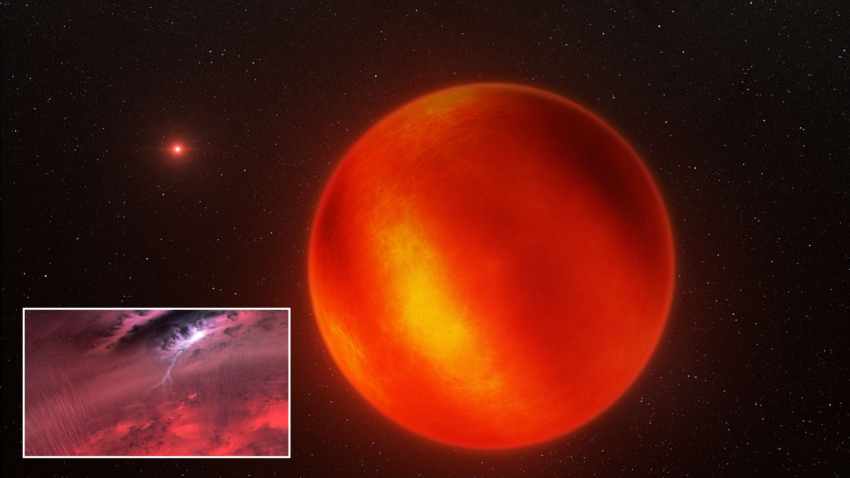Astronomers have created the most detailed weather report so far for two distant worlds beyond our own solar system.
The international study – the first of its kind – reveals the extreme atmospheric conditions on the celestial objects, which are swathed in swirling clouds of hot sand amid temperatures of 950°C (1,742°F).
Using the $10billion (£7.6billion) James Webb Space Telescope (JWST), a joint endeavour of the US, European and Canadian space agencies, researchers set out to capture the weather on a pair of brown dwarfs – cosmic bodies that are bigger than planets but smaller than stars.
These brown dwarfs, named collectively as WISE 1049AB, are the brightest and closest objects of their type to Earth, around six light-years away.
The team tracked each brown dwarf’s atmosphere by measuring the light waves emitted from their surfaces, which change as more or less cloudy regions revolve in and out of view.
By visualising this data through light curves – a plot of how the brightness of light from each object changes over time – the team was able to build up a detailed 3D picture of how the brown dwarfs’ weather changed over the course of a full rotation or day, between five and seven hours.
The team was also able to plot how the light from each object varied by wavelength, to demonstrate the presence and complex interplay of gases such as water, methane, and carbon monoxide in their atmospheres.
The insights may help astronomers develop the understanding of brown dwarfs as a potential missing link between stars and planets – promising new insights into both.
By observing the infrared part of the light spectrum, the JWST is able to observe wavelengths of light that are blocked by our own atmosphere.
This capability opens frontiers in the study of the early universe, star formation, and so-called exoplanets such as brown dwarfs which lie beyond our solar system.
The latest study builds on previous studies of brown dwarfs, which have mainly been confined to capturing static snapshots of their atmosphere on only one side. This approach is limited, as brown dwarfs are known to rotate relatively quickly and their weather can vary greatly over time, researchers say.
Their findings will pave the way for more detailed studies into brown dwarfs and other distant celestial objects.
The study, published in Monthly Notices of the Royal Astronomical Society, was led by the University of Edinburgh in collaboration with researchers from Trinity College Dublin, the University of Virginia, and other institutes from around the world.
Professor Beth Biller said: “Our findings show that we are on the cusp of transforming our understanding of worlds far beyond our own.
“Insights such as these can help us understand the conditions not just on celestial objects like brown dwarfs, but also on giant exoplanets beyond our solar system.
“Eventually, the techniques we are refining here may enable the first detections of weather on habitable planets like our own, which orbit other stars.”
The new study ‘The JWST weather report from the nearest brown dwarfs I: multiperiod JWST NIRSpec + MIRI monitoring of the benchmark binary brown dwarf WISE 1049AB’, Beth Biller et al., has been published in Monthly Notices of the Royal Astronomical Society.
Media contacts
Sam Tonkin
Royal Astronomical Society
+44 (0)7802 877 700
Naomi Imms
University of Edinburgh Press Office
+44 (0) 7814 226015
Science contacts
Professor Beth Biller
Images and captions
Caption: An artist’s impression of the nearest brown dwarf to Earth using data from the European Southern Observatory's Very Large Telescope.
Credit: ESO-I. Crossfield-N. Risinger
Caption: An artist’s impression of the stormy weather on a brown dwarf planet.
Credit: NASA. Secondary Creator Credit NASA - JPL-Caltech - University of Western Ontario - Stony Brook University - Tim Pyle.
Further information
The new study ‘The JWST weather report from the nearest brown dwarfs I: multiperiod JWST NIRSpec + MIRI monitoring of the benchmark binary brown dwarf WISE 1049AB’, Beth Biller et al., has been published in Monthly Notices of the Royal Astronomical Society.
Notes for editors
About the Royal Astronomical Society
The Royal Astronomical Society (RAS), founded in 1820, encourages and promotes the study of astronomy, solar-system science, geophysics and closely related branches of science.
The RAS organises scientific meetings, publishes international research and review journals, recognises outstanding achievements by the award of medals and prizes, maintains an extensive library, supports education through grants and outreach activities and represents UK astronomy nationally and internationally. Its more than 4,000 members (Fellows), a third based overseas, include scientific researchers in universities, observatories and laboratories as well as historians of astronomy and others.
The RAS accepts papers for its journals based on the principle of peer review, in which fellow experts on the editorial boards accept the paper as worth considering. The Society issues press releases based on a similar principle, but the organisations and scientists concerned have overall responsibility for their content.


